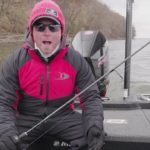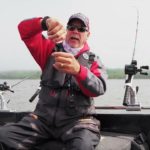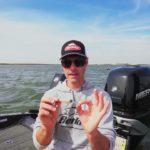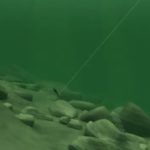Keys To Topwater Success
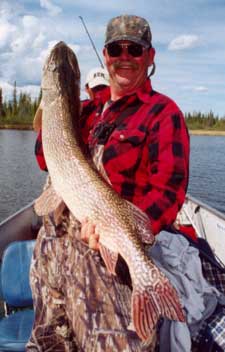
In my personal opinion, there’s no more exciting way to catch any fish than to take them on top. The visual effect just adds so much to the strike. And when you can take big fish on top, well, it just don’t get much better.
Taking big northern pike on topwaters will cause you to go through a wide range of sensations, from weak knees to the hair on the back of your neck standing straight out. When you see the reeds part or that big “hump” of water overtaking your bait. Whoa! Gives me “chicken skin” just thinking about it! The problem is, the window of opportunity is a short one at best and requires both good timing and a good sense of observation. Granted, there are lots of times when you can take pike on topwaters, but most will be smaller fish, under 15 pounds. What I want to discuss here are the times when one can “dance with the big girls”, those pike of 15, 20, even 30 pounds.
Just a couple of weeks after ice out, those dark bottomed bays will start to warm and will signal the first topwater bite of the year. At this time, clouds of minnows will swarm to the shallows to spawn. Pike will already be there recouperating from their spawning activities and they take full advantage of this opportunity. In my opinion, this is the most reliable topwater bite of the year and the best chance to take a real monster on top. It is also the time that an observant fisherman will be able to see where the action is taking place. As these maurading pike slash into schools of minnows, you’ll be able to see the swirls and hear their splashing. That splashing is the sound of opportunity. Keep an eye peeled toward those dead reeds from last year. This is where most of the action will take place.
At this time, I have found that smaller baits are the best offerings. Two of my favorites are a small Rapala Skitter Pop and a Heddon Tiny Torpedo. Anything about three inches long or shorter ought to get bit. These are just my confidence baits. I like to chug these along steadily without the “stop and go” usually associated with these baits. If my timing is right, it won’t chug far before disappearing in a giant “swoosh”. One of my favorite sounds. Another great bait at this time is a Nemire Spoon Buzzer Sr. It’s small and can be retrieved real slow. This is very advantageous as this early pike won’t chase anything moving too fast. Another great feature of this bait is it’s ability to “bulge”. By slowing down the retrieval speed just a bit you can make it run just under the surface making a bulge on top of the water without breaking through. This has a tremendous triggering effect on pike.
Later on, when the new weed growth has grown a bit, I’ve found it best to upsize my baits. Now a long cylindrical bait with a prop or two to stir things up seems to produce better. I’ve done well with the rear prop baits like a Tallywhacker and Mudpuppy. I also like the double prop baits like a Topper Stopper. Retrieves are simple. Just a steady retrieve with a couple of quick twitches once in awhile will usually do the trick. Another one to try is to cast the bait out and let it sit for a few seconds. Then give it a big rip, followed by a steady retrieve. If they weren’t taking notice at the splash down, this big rip will get their attention and a steady retrieve will trigger them. Buzzbaits will draw alot of strikes too but most in my opinion are poor hookers, with the exception of the afore mentioned Spoon Buzzer. They are great search tools though. Look for new weed growth out toward the middle of bays now. Pike will have left the dead reeds and extreme shallows and will be active in slightly deeper water. You may now occasionally notice patches of white stuff on the bottom, anywhere from platter sized to about the size of a garbage can lid. Pike poop! And a sure sign of active pike. If you spot these “piles”, work this area hard.
At this time, I have found that smaller baits are the best offerings. Two of my favorites are a small Rapala Skitter Pop and a Heddon Tiny Torpedo. Anything about three inches long or shorter ought to get bit. These are just my confidence baits. I like to chug these along steadily without the “stop and go” usually associated with these baits. If my timing is right, it won’t chug far before disappearing in a giant “swoosh”. One of my favorite sounds. Another great bait at this time is a Nemire Spoon Buzzer Sr. It’s small and can be retrieved real slow. This is very advantageous as this early pike won’t chase anything moving too fast. Another great feature of this bait is it’s ability to “bulge”. By slowing down the retrieval speed just a bit you can make it run just under the surface making a bulge on top of the water without breaking through. This has a tremendous triggering effect on pike.

Later on, when the new weed growth has grown a bit, I’ve found it best to upsize my baits. Now a long cylindrical bait with a prop or two to stir things up seems to produce better. I’ve done well with the rear prop baits like a Tallywhacker and Mudpuppy. I also like the double prop baits like a Topper Stopper. Retrieves are simple. Just a steady retrieve with a couple of quick twitches once in awhile will usually do the trick. Another one to try is to cast the bait out and let it sit for a few seconds. Then give it a big rip, followed by a steady retrieve. If they weren’t taking notice at the splash down, this big rip will get their attention and a steady retrieve will trigger them. Buzzbaits will draw alot of strikes too but most in my opinion are poor hookers, with the exception of the afore mentioned Spoon Buzzer. They are great search tools though. Look for new weed growth out toward the middle of bays now. Pike will have left the dead reeds and extreme shallows and will be active in slightly deeper water. You may now occasionally notice patches of white stuff on the bottom, anywhere from platter sized to about the size of a garbage can lid. Pike poop! And a sure sign of active pike. If you spot these “piles”, work this area hard.
Another option at this time are the walking baits. Two prime examples are Heddon’s Zara Spook and Muskie Mania Tackle’s Doc. I don’t think there’s a predatory fish out there that won’t hit a Zara Spook. Pike love ’em. The Doc is a good walker, too. It’s easy to use and has a great glide. There’s several walking baits out there and if you can get them to walk, they’ll get bit.
At times, a long minnow bait reeled super slow or just jerked along the top works great, too. I prefer the hard plastic models like a Magnum Bomber Long A or a Storm Shallow Mac. I have some of both that look like they’ve been through a shredder from sliding through those razor teeth. (my favorites!) A good approach to this pattern is to have one fisherman in the front of the boat working topwaters, followed by the other throwing something subsurface, like a spinnerbait. Some of these pike, while still aggressive, seem reluctant to break the surface. These fish will usually slam something running just under the surface though.
As the season progresses and pike leave the shallows for cooler water, another pattern emerges. Cabbage beds are now full and lush and big pike will be found lying near the deep edge. Some will also be found at the bottom of the thickest part of the weedbed. These pike can be called to the top using big jerkbaits. Probably the best lure for this tactic is the Suick or the Burt. The “dive and rise”action of these baits seems to work much better in this situation than the glide type of jerks which seem to get tangled in the weeds more often. Retrieves are simple, but keep in mind that you want to keep that lure mostly on top, so short jerks are in order now. It’s my opinion that the little splash a Suick makes as it dives is at least partially responsible for calling these pike from their deep haunts. Squirrley Burts do it too. That, coupled with the injured look are enough to trigger these pike into striking. This can be one of the very best tactics to use on these hard to find and catch summer big pike. Yet another successful way to put a Suick to use is through trolling. Right through the thick weeds. It’s an easy matter to just slow troll through this thick cabbage, trailing a Suick and short jerking it along. Hang onto that rod tightly. When one of these deep weed pike hits a trolled Suick, it’ll feel like a freight train! Heavy tackle is the order of the day here. Best use some good line too as they’ll undoubtably dive into that thick cover and if it’s a real big fish, it won’t want to come back up. Most of the time, you’ll have to chase down these fish with the boat, positioning over the top of them and wenching them up. Use light tackle here and you’re toast!


